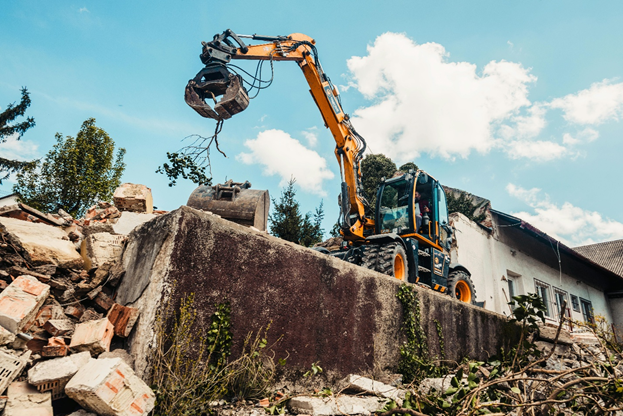Starting a new build is exciting, but ground-up projects don’t begin with hammer and nail. They start with dirt, roots, and a plan. Clearing the site the right way sets you up for a sturdy foundation, smooth workflow, and fewer budget surprises later on.
In this guide you’ll walk through each stage of the site-clearing process so you can tackle (or oversee) it with confidence. Follow this page https://www.maramani.com/blogs/home-design-ideas/site-clearing for more details.
Site-Clearing Basics Explained
Every successful clearing job follows a tight playbook that keeps inspectors happy and money in your pocket. Think of it as building a house in reverse: instead of stacking walls upward, you carve the Earth downward until it can support anything you throw at it.
- Survey and flag. A licensed crew marks property lines, setback limits, and utility corridors. Those fluttering flags may look simple, yet they save thousands by preventing accidental encroachment and surprise wire strikes. You’ll also photograph the markings for your records, proving you stayed inside the legal bubble.
- Protect against erosion. Before the first scoop, silt fences and straw wattles go down. They slow muddy runoff, protect nearby creeks, and keep you on the good side of environmental inspectors. Make sure each barrier is trenched at least six inches into the soil; a loose fence flops over in the first storm.
- Clear, grub, and strip. Crews armed with heavy machinery-excavators, stump grinders, and brush cutters-fell trees, yank stumps, and peel off spongy topsoil for later landscaping. Stay close with a notebook; deciding which trees to save now is cheaper than re-planting shade later.
- Rough grade and compact. Bulldozers push soil into plan-approved slopes, then rollers perform soil compaction in six-inch lifts. That slow, rhythmic packing feels tedious, but it guarantees the ground won’t settle under future footings, driveways, or patios.
- Stabilize for weather. If the site might sit idle for weeks, crews spray mulch or plant fast-germinating rye to lock the surface in place. One afternoon of seeding can prevent torrential rains from erasing days of earthwork.
Knowing this order keeps inspectors happy and your timeline intact.
Why Remove Vegetation First?
It’s tempting to skip straight to grading but living roots keep growing even after the canopy is trimmed. When those roots finally die, they rot and create voids that crack concrete and buckle pavers. Removing vegetation first also increases safety. Without tangled vines, operators can spot hidden hazards like old septic lids, abandoned wells, or splintered fenceposts waiting to shred a tire. Faster grading follows because dozers glide over bare dirt instead of chewing through thorny brush. Lastly, you cut off the welcome mat for rodents and termites that love fresh brush piles.
If your lot is small, you can fell saplings yourself, yet calling in a land clearing contractor to drop mature oaks safely will save weekends, rental fees, and nerves. Remember that most municipalities require a tree-removal permit; submit it early so the logger isn’t waiting on paperwork while your schedule bleeds.
Managing Debris and Waste Safely
Land clearing creates mountains of limbs, logs, and the occasional buried surprise. A tidy waste plan keeps neighbors happy and your timeline intact.
- Chip clean wood on-site. The resulting mulch is perfect for garden beds, erosion blankets, or even biomass fuel, and it sidesteps landfill fees.
- Sort scrap metal-old fencing, irrigation pipes, or rusted rebar-and trade it for cash at the recycler. A single trailer of steel can cover a day’s equipment fuel.
- Rent a roll-off dumpster for mixed debris and schedule pickups around wet weather so soggy loads don’t blow past weight limits. Confirm driveway strength first; a full 20-yard bin can weigh eight tons.
- Call specialists for hazards. If you unearth a fuel tank or asbestos siding, don’t improvise. Certified remediation avoids fines that can dwarf your entire material budget.
Many homeowners hunting for site clearing Lebanon solutions discover local haulers who bundle debris removal with erosion-control supplies, simplifying the whole operation.
Grading for Drainage 101
A flawless foundation still fails if rainwater flows the wrong way. Professional excavation and grading crews start by shooting elevations with a laser level or GPS rover (check this forum for additional insights), marking highs and lows on wooden stakes. You’ll see numbers like “-1.4” spray-painted on the stakes; those are cut or fill depths in feet.
They then slice the ground to create a gentle two-percent slope-about a quarter inch per foot-away from future walls for at least ten feet. Swales guide stormwater into culverts or rain gardens, while compacted berms stop flash floods from invading low entries. Timing is everything: working saturated soil leaves ruts, ruins compaction, and invites permit violations when mud slides onto the road.
Before the crew demobilizes, walk the lot with your phone’s compass app to double-check that slopes fall in the direction the plan shows. A five-minute inspection today can save thousands in French drains tomorrow.
How Long Does Clearing Take?
Durations hinge on size, terrain, and machine count-but also on weather, permit waits, and crew skill. A wooded rural acre usually needs three to five days with an excavator and skid steer, assuming average tree density and decent haul routes. A tight suburban quarter-acre can wrap up in a single long day if driveway space allows trucks to turn around quickly. Pasture with light brush? Plan four to seven days using a mid-size dozer and compact track loader. Steep, rocky, or wet land can double those estimates due to rock breaking, dewatering, or mandatory dry-back delays.
Whatever your estimate, add two floating “rain cushion” days per week during wet seasons. That buffer keeps follow-up trades like concrete or framing from stacking up and charging standby fees.
Wrapping Up
From flagging boundaries to final erosion control, site clearing is part science, part choreography. Master the sequence-survey, protect, remove vegetation, manage waste, grade, and compact-and you’ll turn wild ground into a rock-solid pad ready for footings. Whether you rent equipment for weekend warrior projects or hire specialists, a clear, well-drained lot is the best insurance policy against future cracks, leaks, and budget creep. Treat the land the way you treat your tools: keep it clean, stable, and ready to perform, and the rest of your build will rise on schedule and on budget.





